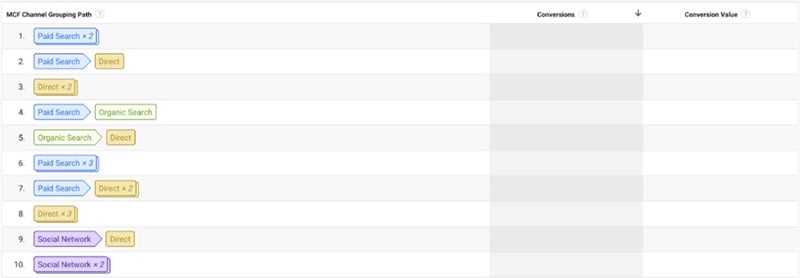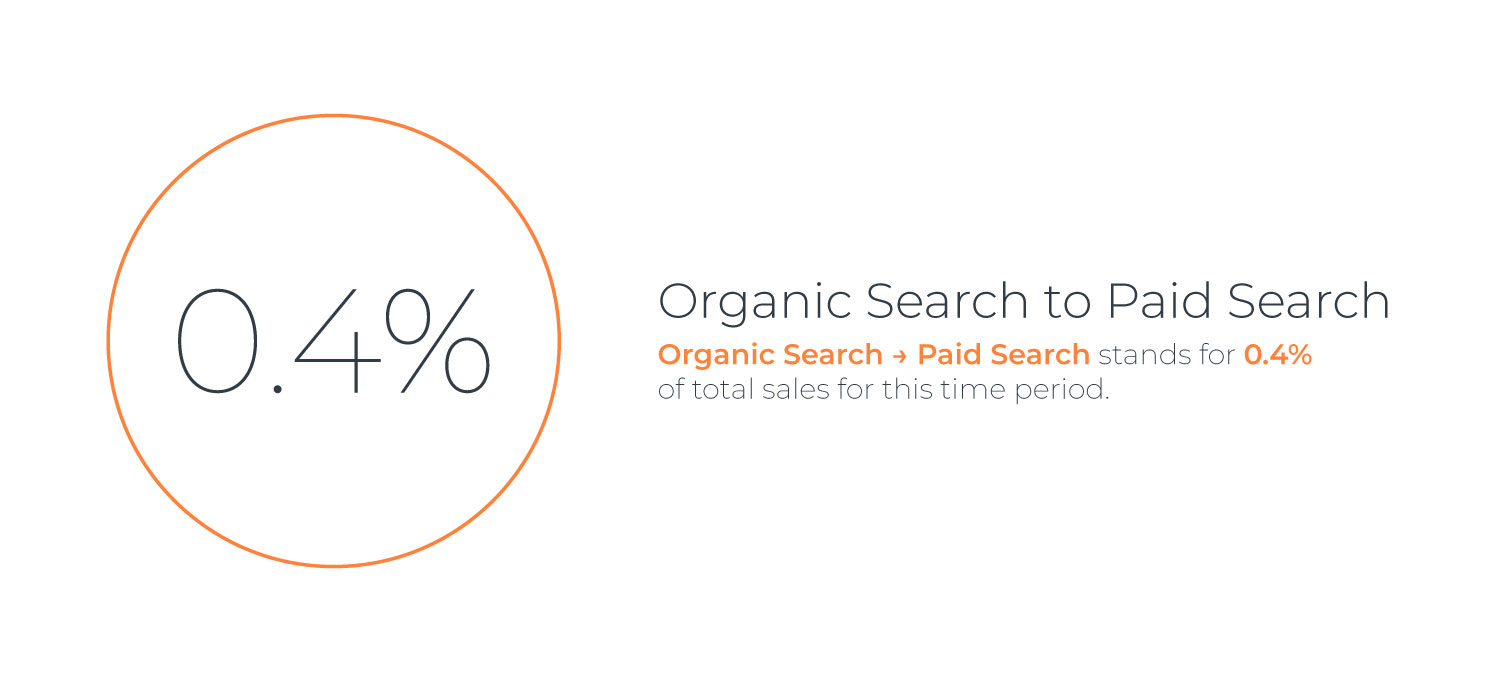

Get monthly notifications
Does Google Ads Cannibalise On Organic Traffic?
A primary query that most clients pose is – “How much traffic will Google Ads thieve away from organic channels in general.”
This happens to be a major concern for most business owners. Why pay for
something you can get done for free?!
We aimed to figure out that very same puzzle. (You’re welcome!)
Is Google Ads, the Robin Hood to other organic channels or does it take away from them and keep to itself?
That is the question!
To complete a successful attempt at understanding this enigma, several ecommerce accounts were put through Google’s Analytics grinder.
We will be expanding on the results in this document.
Bear in mind though, we are talking about accounts that have had more than one touchpoint.
So, if a client were to hypothetically, to punch in the URL to your portal and purchase some of your ‘merch’, (nice bubble) you aren’t going to find them in the reports we’re touching upon in this article.
The most common path taken by clients who utilize Google Analytics is that of paid search x2.
In layman speak, if John/Jane Doe were to click on a paid ad twice before making a purchase, it would account for 2.5% of the total sales, during that respective period.
The second most common path to conversion is that of a client approaching your business directly.
As in, if Mr. or Ms. Doe stumbled upon your website by way of a google shopping ad, and upon learning of your company’s existence, were to come back to said portal and make a purchase – this would result in a ‘direct sale.’
Although paid search x2 amounts to more conversions, paid search (direct) accounts for higher revenues.
By how much you ask?
3.4% of the total sales.
And, through Google Analytics, this is flagged as a direct conversion, irrespective of the fact that the client first found your business through a paid source.
With further progression down the depicted image, it has been found that paid search results in direct x2.
You get the gist as to how we got there.
If not, what we’re stating is that, despite a prospect clicking on a paid ad, they ended up arriving at your portal ‘directly’ not once, but twice.
This accounts for 2.1% of the total sales.
We also found that paid search results in organic search. Slotting itself among the top five positions.
But it only accounts for 0.8% of the total sales.
The belief that by using Google ads, you’re paying for clicks that you would have secured for free, and hence the assumption that you’re paying for conversions that would have been achieved without a penny being spent.
The truth is that you must examine the report thoroughly get the whole picture. Organic search through paid search accounts for 0.4% of the total sales.
What this means is that organic pathways generate more sales when paid search is the first point of contact rather than when the organic route is the first touchpoint that is followed by the clicking of a paid ad.

Here is a summary of the top 50 conversion paths where paid ads were involved:
- Paid → Other Channels accounts for 12% of total sales
- Other Channels → Paid (cannibalism) accounts for 1.5% of the total sales
To conclude - paid search isn’t thieving potential revenue from other respective channels.
In fact, it’s the other way around.
However, the belief that Google ads are ‘cannibalizing’ on other channels, is true, to a degree.
But that amounts to a mere 1.5% of the total sales. A drop in the ocean.
This in a little clip to understand why its necessary to understand organic traffic in relation to how you can optimize paid traffic.
If you enjoyed that preview, watch the entire webinar here.
If you’re curious about how the other respective channels for your business are performing, then follow the given map - log on to Google Analytics and access the conversions column located on the bottom left.
Once there, go to multi-channel funnels and then to top conversions.
You will find the report you seek there.
If you have any difficulty doing so or have other related queries, don’t hesitate to give us a bell, and we’ll be glad to be of help.
Featured Articles
The Full Funnel Approach and Pinterest
Today, we're going to delve into the significance of working with a full-funnel strategy and understanding why a comprehensive media mix is crucial. We'll also explore an example of how this approach and including Pinterest in the media mix led to a significant decrease in the cost of sales for Houdini.
Master Text Overlays: Boost Ad Engagement
In recent years, capturing the attention of your target audience has become more challenging than ever. Businesses and marketers are constantly on the lookout for innovative ways to stand out in the crowded advertising landscape.
One effective technique to draw attention to your ad's message is through the use of text overlays on image and video ads. In this blog, we will explore the best practices for incorporating text overlays, ensuring your message is impactful without compromising the visual appeal of your ads.
Similar Articles
Protect Your Facebook Business Account from Phishing: Expert Tips by Keywordio
Hello everyone, Johan here from Keywordio. Today, I want to share crucial insights into phishing—what it is and how you can safeguard your Facebook business account from this prevalent threat.
Exploring the Future of TikTok: Insights from the 2024 Trend Report
Introduction
I'm excited to delve into TikTok's comprehensive "What's Next 2024 Trend Report." This report is a treasure trove for anyone in digital marketing, offering deep insights into the future of content, storytelling, and consumer engagement on TikTok.
E-Commerce Excellence: Meta's Advantage+ Shopping Campaigns Redefined
Welcome to the dynamic world of e-commerce, where Meta's Advantage+ shopping is reshaping how businesses connect with customers. In this blog post, we'll explore the key features of this innovative tool.
Introducing TikTok Shop
Today, I bring to your attention a revolutionary update from TikTok, a platform where over 150 million Americans seek daily doses of inspiration and entertainment. With a plethora of trends, fashion hacks, beauty nuggets, and a smattering of recipes, TikTok has emerged as a modern-day oracle for curious minds. The excitement in the air thickens as we unveil TikTok Shop to the US, an avant-garde conduit for folks to spot and snag their adored items seamlessly.
The Full Funnel Approach and Pinterest
Today, we're going to delve into the significance of working with a full-funnel strategy and understanding why a comprehensive media mix is crucial. We'll also explore an example of how this approach and including Pinterest in the media mix led to a significant decrease in the cost of sales for Houdini.
Master Text Overlays: Boost Ad Engagement
In recent years, capturing the attention of your target audience has become more challenging than ever. Businesses and marketers are constantly on the lookout for innovative ways to stand out in the crowded advertising landscape.
One effective technique to draw attention to your ad's message is through the use of text overlays on image and video ads. In this blog, we will explore the best practices for incorporating text overlays, ensuring your message is impactful without compromising the visual appeal of your ads.
The Next Big Thing: 5 Digital Marketing Trends to Watch for in 2023
Digital marketing is a constantly evolving field, shaped by emerging technologies, changing consumer behaviors, and the dynamic nature of the online landscape. Staying on top of the latest trends is crucial for businesses and marketers to effectively engage with their target audience and drive growth. In this introduction, we will explore some of the key digital marketing trends that have emerged in recent times.
The Power of Branding on Meta
Are you ready to unlock unparalleled opportunities and take your online business to new heights? In a rapidly evolving digital landscape, Meta continues to revolutionize the way marketers and entrepreneurs create an impact on buyers.
Today, we will talk about the immense potential of branding on Meta's platforms, Facebook and Instagram based on our Meta Branding (Online Course). Brace yourself for insights that will empower you to establish a strong brand identity, harness consumer trends, and optimize your advertising strategies like never before! Ready to spearhead your business to success? by understanding the potential of branding on Meta and how you can tap into it. Excited? So are we - let's get into it!
A Sneak Peek into Pinterest's 2023 Product Updates!
Pinterest is improving its Ads Manager to provide a seamless experience for advertisers. New features will be released throughout 2023 to optimize advertising strategies. Pinterest aims to offer powerful tools and insights for better campaign results. Get a sneak peek into the exciting updates coming to Ads Manager this year.